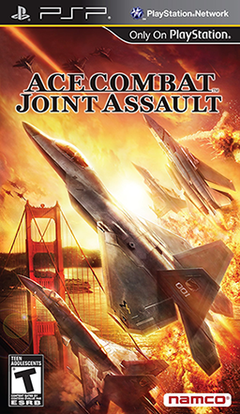Characters
Joint Assault is set between 2010 and 2011 in a rendition of the real world, as opposed to Ace Combat's typical fictional setting of Strangereal. Up to four players assume the role of Antares Squadron, pilots hired by a private military company called Martinez Security, assigned under the command of Lieutenant Colonel Frederick Burford. Another squadron within the company, Rigel, consists of pilots Milosz Sulejmani, Daniel Oruma, Faryd Gaviria, and Tolya Kiriakov. The game's antagonists are Romanian Colonel Nicolae Dumitrescu and international insurance businessman Andre Olivieri.
Story
During a military exercise involving Martinez Security, the U.S. Seventh Fleet, and the Japan Maritime Self-Defense Force off Midway Atoll, the international high-tech terrorist group Valahia launches a massive attack on Japan. Antares and Rigel Squadrons support the Seventh Fleet and the JSDF in the defense of Tokyo, the Izu Islands, and the Bōsō Peninsula, while also destroying Valahia's airborne aircraft carrier Orgoi and damaging their aerial battleship Spiridus. However, Rigel Squadron defects to Valahia upon accepting a lucrative offer by Dumitrescu, Valahia's leader.
Embarrassed by the defection, Martinez Security joins the International Union Peacekeeping Force (IUPF), a global coalition tasked with defeating Valahia, who are active in the Middle East and the Balkans. During a mission over the Adriatic Sea, Antares encounters Rigel, now calling themselves Varcolac Squadron. Antares manages to destroy Spiridus over London and the railgun emplacement Balaur in Romania, crippling Valahia's combat capabilities and leaving them without superweapons. After Antares One is briefly reassigned to fly major IUPF financier Andre Olivieri's personal Boeing 747-200B through Valahia-controlled territory, Antares and the IUPF assault Valahia's missile silos in Central Asia before they can launch nuclear missiles at North America and Europe, killing Dumitrescu and dismantling Valahia.
During the assault on the missile silos, Antares engages Varcolac and learns of the "Golden Axe Plan", a conspiracy formulated by Olivieri. An extremely wealthy insurance magnate whose company was on the verge of bankruptcy following the Great Recession, Olivieri secretly supported Valahia's attacks on major cities, disrupting the economy and scaring the public into buying his company's war risk insurance plan, with the goal of ultimately gaining a monopoly over the global insurance market and making him the richest person in the world. After the destruction of Spiridus, Valahia had betrayed Olivieri to pursue their own plans of forming a state.
While resupplying at Midway Atoll, Antares is attacked by Olivieri's private army and a fleet of new Orgois, but they repel the attack. Knowing the final steps of the Golden Axe Plan involve an attack on the United States, Martinez Security deploys to Nevada to defeat Olivieri's private army and destroys their improved Spiridus over Lake Tahoe. Olivieri's private army launches their planned attack on San Francisco, but are defeated by Antares, who also defeat Varcolac in a final duel. Antares bombs the entrance to Olivieri's headquarters, killing him and allowing ground forces to infiltrate the building and expose the Golden Axe Plan to the world.
